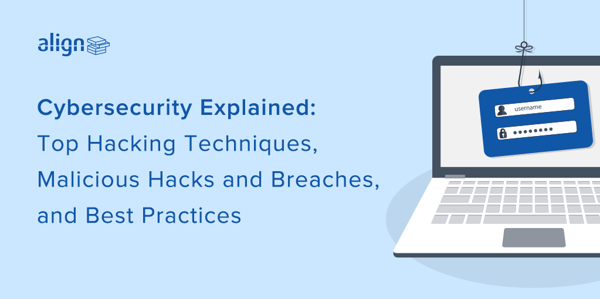To adequately protect your business from malicious cyber-attacks, it's critical that users understand the techniques cybercriminals use to carry out their attacks, as well as, prevention methods and security best practices.
In today's blog, we’ve outlined some of the most conventional hacking techniques, rounded up infamous data breaches and offered actionable tips for protecting your business.
 Top Hacking Techniques
Top Hacking Techniques
The most common hacking techniques are simple and highly effective, which is why cybercriminals tend to recycle them. Here are a few common attack vectors to look out for:
- Malware – This refers to various types of harmful software, including viruses and ransomware, that can gain access to your computer and send confidential data from your device or network to the attacker’s database.
- Phishing – Phishing is a form of social engineering that hackers utilize to trick victims into clicking on a link or opening an attachment to download malware onto their computers. Criminals will often disguise themselves as someone you trust, whether it’s a boss or a vendor you do business with, and will create a sense of urgency to motivate you to provide confidential information. To avoid falling for this tactic, make sure that you perform adequate due diligence when reading emails and notify the proper personnel of any suspicious activity.
- SQL Injection – This web attack targets companies that use SQL to access information from their database. Hackers will employ malicious code to manipulate the backend databases to obtain information that’s not displayed. Successful SQL Injection attacks can wipe entire databases, putting customer data at risk and potentially tarnishing your company's reputation if client information is hacked.
Significant Hacks and Data Breaches of 2018
The effects of a data breach can be devastating and ripple throughout an organization, leading to damages of catastrophic proportion. The following is a snapshot of some of last year's most crippling cyber-attacks and data security breaches:
- Bank of Montreal and Canadian Imperial Bank of Commerce – Two of Canada's biggest lenders reported that fraudsters compromised 90,000 customers' records in May 2018.
- Aadhar Database – Over 1.1 billion registered Indian Citizens demographic and biometric information was exposed from a leak in the government’s database. Hackers got access to fingerprints, banks accounts and government records.
- Marriot Starwood Hotels – Financial information, passport copies and mailing addresses from over 500 million guests were stolen from their database in late September 2018.
- MyFitnessPal – 150 million usernames, email addresses and encrypted passwords were hacked in a cyber-attack in February 2018.
- Facebook – Over 30,000,000 users' records were hacked in September 2018, exposing personal data such as religion, date of birth, check-in locations, associated companies, names and more.
- Quora – In November 2018, Quora’s internal systems were breached and affected over 100 million users’ email addresses, passwords, IP addresses, personal data and records of all questions asked on the platform.
Cybersecurity Best Practices
Businesses face the daily challenge of protecting the confidential data, personal information and assets of their clients and employees against sophisticated, experienced hackers. To help develop your company's cyber preparedness and prevent hackers from getting in, we've outlined a few pro-recommended tips:
- Employ Cyber Specialists – Partner with a cybersecurity service provider to create a holistic cybersecurity program that addresses your unique business needs and meets emerging regulatory requirements.
- Foster Awareness – Enact company-wide employee cyber awareness training on risks, threats, mitigation and remediation. Advanced and insightful education modules will help keep users up-to-date with the latest hacking trends, detection techniques and response best practices to prevent a breach from occurring.
- Risk Assessments – Assess your current IT infrastructure to identify threats and vulnerabilities and reduce risk.
- 24x7x365 Monitoring – Leverage 24x7x365 monitoring to detect threats before they impact your company.
- Protect Sensitive Business Information – Implement robust security controls and educate employees on proper protocol. Limit access to sensitive business data to a set number of employees and have strict guidelines that those respective staff members need to follow.
Align's Managed IT Services team helps clients address evolving cybersecurity risks and their threats through a streamlined, multi-faceted approach. If you're exploring cybersecurity solutions for your firm or are seeking more information about our award-winning services, contact us here or email at cyber@align.com.




